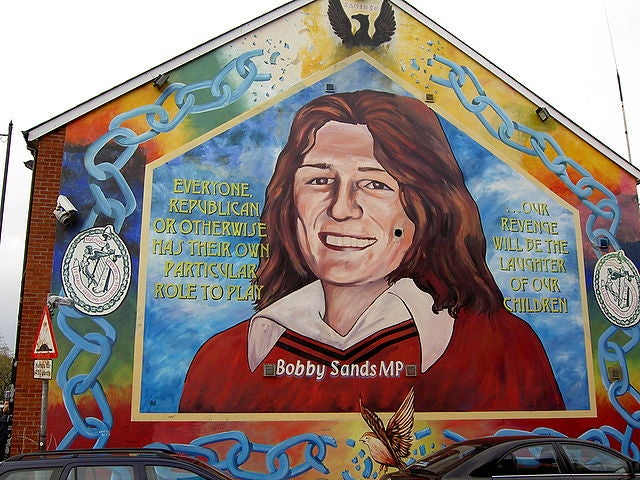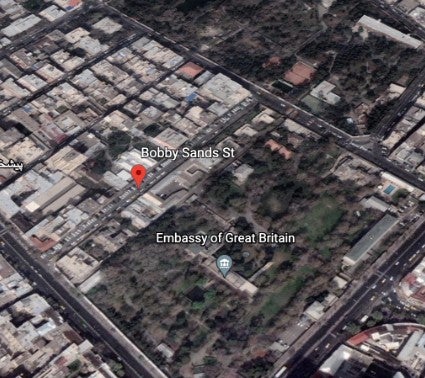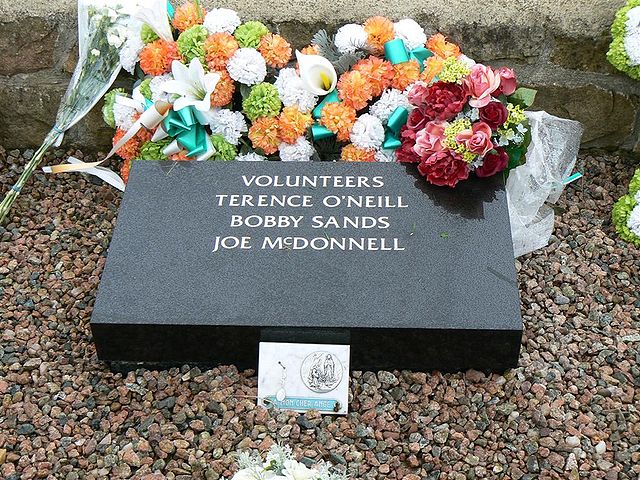Bobby Sands in Tehran: Memorialization or Exploitation?
Colleen Baer (COL ‘22) is a senior with a double major in Government and English and a minor in Theology. Throughout her time at Georgetown, she has taken several classes with Irish-related modules.

A Google search for the British Embassy in Iran will return several key facts–hours of operation, social media profiles, a phone number. Included among this basic information is the embassy’s address–an unremarkable entry, simply noting its location on Ferdowsi Avenue. What this straightforward listing fails to capture is how this address came to be. The Ferdowsi Avenue label is the product of a deliberate decision in 1981, when British officials moved the entrance to the building. The name of the street on which the old entrance had been was a source of consternation for British officials; what had previously been Winston Churchill Street was renamed for Bobby Sands, a hunger striker in Northern Ireland who had starved to death in prison. The decision by Iranian authorities to rename the street had been a conscious attempt to frustrate embassy officials and embarrass the British government. The fact that embassy officials went to the trouble of moving the entrance confirms that these objectives were met. While this exchange between governments may seem petty in a world filled with more pressing crises, this struggle over the name of an Irish hunger striker speaks to a broader tension between memorialization and exploitation.
I first learned about Bobby Sands Street while doing research for a final project in a theology class called “Martyrdom and Meaning.” Our assignment was broad: examine a case of martyrdom that we had not looked at in class. I eventually settled on the Irish hunger strikers as the center of my paper. As I researched the idea of these men as martyrs, I was struck by how both the Iranian street name and murals in Northern Ireland highlight the strange dynamic between honor, dehumanization, and appropriation that characterizes the public memory of larger-than-life figures.

The naming of Bobby Sands Street was preceded by Sands’ conversion into a ubiquitous symbol of the struggle in Northern Ireland. On March 1, 1981, Sands initiated a hunger strike dedicated, in part, to the demand that special category status should be reinstated for prisoners incarcerated for Troubles-related charges. Sands, whose strike was followed by that of nine other men, became the first to die, after sixty-six days of refusing food. Almost immediately after his death, Sands’ republican comrades raised him to martyr status, and he quickly became one of the most frequently depicted figures on murals across Northern Ireland. Murals depicting Sands assume his martyrdom and present him as a superhuman figure, and they became one vehicle through which Sands and other strikers were “elevated into the pantheon of heroes.”¹ As images of Sands proliferated around nationalist neighborhoods, he became more symbol than human, standing for the wider suffering endured by Catholics and nationalists in Northern Ireland. His image was a tool in the fight to rally more people to the republican cause, a constant assertion of the nobility of republican ideals. Regardless of whether Sands would have endorsed these recruitment efforts, there is an element of dehumanization inherent in reducing any individual to a symbol. It flattens a person who had complex motivations and ambitions into just a name or a face. The image or name becomes shorthand for the broad idea the individual represents rather than the life of the human being. Once a person and an idea have become synonymous, their symbolic presence is available for all to invoke.
The Iranian government’s use of Sands’ name exposes the dangers of symbols; they can be used by anyone looking to legitimize their claim to a higher ideal, even as the party’s actions may violate it. As the Iranian government memorialized Sands and became champions of the republican cause, “many imprisoned Iranian opposition members were conducting their own hunger strikes to protest against IRI’s brutal prison regime.”² Iranian advocacy for Irish republicanism came in part because of, rather than despite, these Iranian hunger strikes. Casting the regime as fighting for the oppressed in Northern Ireland had a delegitimizing effect on strikers within Iran. Having demonstrated the regime’s willingness to support “legitimate” strikers, Iranian strikers are discredited, and the Iranian regime could use Sands’ name to shape their propaganda narrative as a party defending freedom. This memorial for Sands was disconnected from Sands’ own vision for the meaning of his strike, but his status as a public symbol made his legacy vulnerable to being co-opted. With Sands being inextricably tied to a larger, more nebulous notion of political freedom, his name was a useful slapdash signifier of respect for this value, regardless of whether this respect was merely superficial.

The Irish and Iranian uses of Sands may occupy opposing ends of the exploitation spectrum; Irish uses were meant to further the cause to which Sands had given his life, while the Iranian memorial resulted in the diversion of attention away from Iranian repressive practices. However, both highlight the delicate balance between an earnest desire to honor an individual and the use of a revered legacy to further selfish interests. This phenomenon is hardly restricted to Sands or the wider Northern Irish example. It is a constant presence, surfacing each time someone divines what causes a former president, civil rights icon, sports star, or industry titan would have supported. The elevation of public figures into these symbolic forces is not inherently malevolent, but it should give us some pause, reflecting on the implications of turning a human being into a virtue signal, available to be referenced when aligning oneself with the public understanding of that person’s values. Next Martin Luther King Jr. Day, as I read the tweets sent out by billion-dollar multinational corporations and the FBI, situating themselves as disciples committed to King’s vision, I will be thinking of Bobby Sands Street in Tehran and of what these acts of memory can obscure.
¹ Hopkins, Stephen. “‘Our Whole History has been Ruined!’ The 1981 Hunger Strike and the Politics of Republican Commemoration and Memory,” Irish Political Studies, 28 January 2016, https://doi-org.proxy.library.georgetown. edu/10.1080/07907184.2015.1126927, pp. 49.
² Bonakdarian, Mansour. “Iranian Consecration of Irish Nationalist ‘Martyrs’: the Islamic Republic of Iran and the 1981 Republican Prisoners’ Hunger Strike in Northern Ireland,” Social History, 2018, pp. 296.
